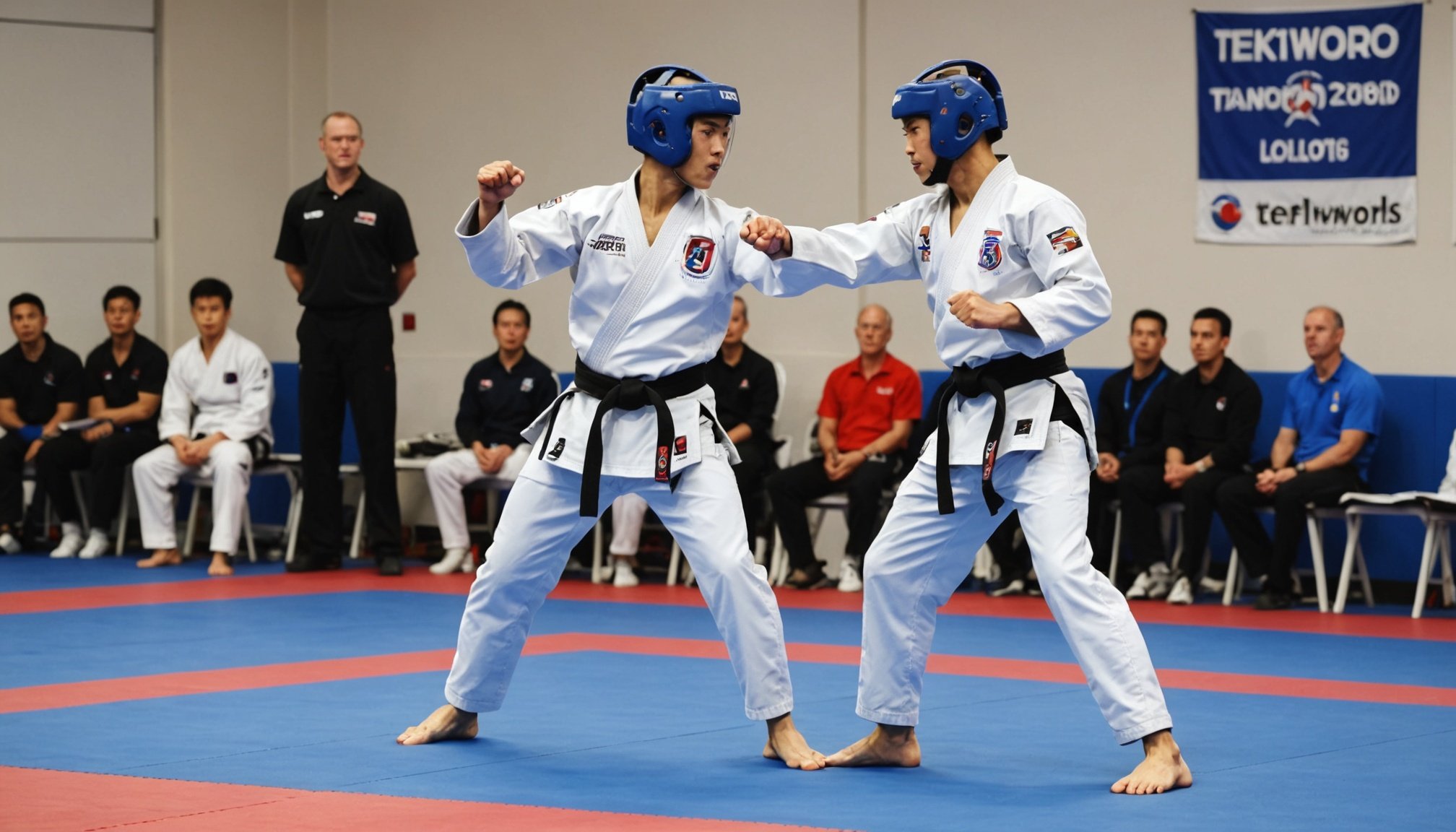Understanding Competition Day Stress
Navigating competition day stress in a taekwondo setting is a multifaceted challenge, deeply affecting athletes both physically and mentally. In the UK, competitors often face unique stressors such as performance expectations from peers, coaches, and spectators. Taekwondo anxiety manifests through various symptoms, dampening an athlete’s spirit and potentially reducing performance quality.
The psychological impact is profound, often leading to intense performance pressure. This pressure creates a loop of self-doubt and fear of failure, which might impair focus. Athletes frequently report feelings of being overwhelmed, attributing this to high stakes and personal aspirations. With stress levels peaking, their ability to execute precise skills efficiently diminishes, posing a hurdle to achieving success.
Additional reading : Ultimate guide to elevating performance: weight training strategies for uk sumo wrestlers
Performance anxiety can cause both mental blocks and physical symptoms, which may negatively impact coordination and decision-making under pressure. Understanding this psychological terrain is crucial to managing stress. Techniques such as breathing exercises, visualization, and mindfulness can be effective, enabling competitors to tackle stress head-on. By fostering a supportive environment, coaches and peers can assist in alleviating anxiety, helping athletes to surpass competitive hurdles and attain peak performance. Recognizing the signs early allows interventions to combat stress, promoting mental resilience.
Breathing Techniques for Stress Relief
In the high-pressure world of taekwondo, mastering breathing exercises is vital for stress management and performance enhancement. Properly harnessed, these techniques offer competitors a natural method to calm nerves and improve focus.
Also read : Unlocking the art of sweeps: key strategies for uk sanda practitioners to enhance their skills
Diaphragmatic Breathing
Diaphragmatic breathing, also known as deep breathing, helps lower heart rate and induces relaxation, making it particularly beneficial during stressful moments. By focusing on the breath and ensuring it expands the diaphragm, athletes can experience reduced taekwondo anxiety, allowing for better mental clarity and physical performance.
Box Breathing
Box breathing is another effective technique, involving equal parts inhalation, holding, exhalation, and pausing. This method encourages steady control of breathing, which is particularly advantageous during competition day stress. Regular practice helps competitors maintain composure under intense performance pressure.
4-7-8 Breathing Technique
The 4-7-8 breathing technique is a relaxation tool involving inhalation for four seconds, holding for seven, and exhaling for eight. This technique aids in lowering stress levels rapidly, proving useful for athletes facing last-minute anxiety before matches. By integrating these exercises into training routines, competitors enhance both mental resilience and focus, elevating their readiness and efficiency in taekwondo arenas.
Visualization and Mental Preparation
In the realm of visualization techniques, competitors can significantly enhance their competition readiness. Creating a mental image of success allows athletes to vividly imagine executing their skills flawlessly, instilling confidence and determination. Elite athletes often engage in this practice to build mental pathways that support real-time performance enhancement.
Creating a Successful Competition Mental Image
To harness the power of mental imagery, athletes should develop a clear picture of their desired outcomes during competition. This involves visualizing each movement with precision and feeling the emotions associated with success, such as pride and accomplishment. Developing such an image strengthens mental fortitude and can be integrated into daily training routines.
Utilizing Visualization During Sparring
By incorporating visualization techniques into sparring sessions, competitors can mentally rehearse responses to various scenarios. This preparation not only boosts their confidence but also sharpens their strategic thinking. Practising this form of mental imagery helps competitors adapt quickly and effectively during live matches.
The Role of Visualization in Overcoming Performance Anxiety
Visualization acts as a tool in overcoming performance anxiety, providing a mental rehearsal space that calms nerves. By repeatedly imagining successful performances, athletes can reduce the taekwondo anxiety that often accompanies high-pressure situations. This proactive approach empowers athletes to approach competition day with mental clarity and assurance.
Mindfulness Practices for Competitors
In the realm of competitive taekwondo, integrating mindfulness practices into training can substantively enhance mental resilience and focus. Mindfulness is the practice of being present and fully engaged in the current moment without judgment, which maximizes focus enhancement and reduces anxiety.
Developing a Mindfulness Routine
Creating a consistent mindfulness routine tailored to athletic needs can fundamentally improve performance. Athletes are encouraged to dedicate 10-15 minutes daily to mindfulness exercises such as meditation or yoga, which can enhance clarity and composure.
Mindfulness Techniques for Real-Time Stress Management
During competitions, utilizing techniques such as mindful breathing or body scanning provides real-time stress relief. Mindfulness tools normalize heart rate and refocus energy, optimizing the athlete’s mental state amidst intense conditions.
Incorporating Mindfulness into Taekwondo Training
Incorporating mindfulness practices into regular taekwondo training fosters long-term benefits. Athletes often engage in mindful sparring, consciously observing motions and decisions without reactive pressure. This practice not only polishes skills but also ingrains resilience and adaptability under match stress, preparing competitors for diverse scenarios. Thus, consistent mindfulness practice is pivotal for surpassing psychological and physical hurdles in competitive arenas.
Competition Preparation Strategies
In the journey to minimize competition preparation stress in taekwondo, a strategic approach to pre-event routines is indispensable. Creating athlete routines tailored to individual needs helps manage stress effectively and enhances readiness. Structured rituals, such as having consistent pre-competition rituals or routines, provide comfort and familiarity, reducing anxiety by creating a sense of control.
Pre-Competition Rituals
Engaging in familiar rituals, from specific warm-up sequences to listening to preferred music, aids in setting the mental stage for performance. These rituals can serve as mental cues, anchoring athletes in a positive, focused mindset.
Nutrition and Hydration Tips
Adequate nutrition and hydration are foundational for optimal performance. Focusing on balanced meals rich in proteins, carbohydrates, and hydration elevates energy levels, maintains focus, and supports physical stamina. Avoid last-minute dietary changes to prevent adverse impacts on performance.
Physical Warm-Up and Mental Check-In
A comprehensive physical warm-up primes the body, while a mental check-in ensures psychological readiness. Techniques such as light stretching or jogging coupled with brief meditation or affirmations cater to both physical and mental demands. Integrating these strategies into preparation routines fortifies both body and mind against pre-competition stressors.
Personal Experiences and Expert Insights
In the realm of taekwondo, both athlete stories and expert opinions provide valuable insights into managing competition day stress. Interviews with elite taekwondo competitors often reveal common struggles and triumphs, offering relatable experiences. Athletes share tales of overcoming intense pressure and taekwondo anxiety, highlighting personal growth through challenges faced.
Successful athletes frequently cite the role of routine and mental preparation in their achievements. They employ strategies like relaxation techniques and visualization to combat stressors. These insights shed light on the practical applications of stress management techniques under high stakes.
From the perspective of coaches, guiding athletes through the turbulence of competition involves reinforcing mental resilience. Coaches emphasize creating a supportive environment that empowers athletes to address fears and focus on their strengths. By promoting consistent routines and mindful practices, they aim to ease anxiety and enhance performance readiness.
The taekwondo community serves as a rich source of inspiration, with practitioners sharing lessons learned from their competitive experiences. These collective stories not only offer encouragement but also underscore the importance of perseverance and strategic planning in navigating the complex landscape of martial arts competitions.











